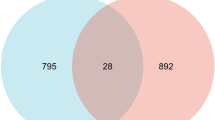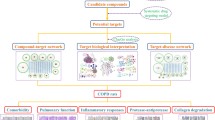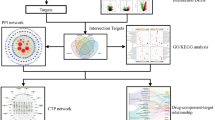Abstract
Pulmonary hypertension, a common complication of chronic obstructive pulmonary disease, is a major global health concern. Green tea is a popular beverage that is consumed all over the world. Green tea’s active ingredients are epicatechin derivatives, also known as “polyphenols,” which have anti-carcinogenic, anti-inflammatory, and antioxidant properties. This study aimed to explore the possible mechanism of green tea polyphenols in the treatment of pulmonary hypertension using network pharmacology, molecular docking, and experimental verification. A total of 316 potential green tea polyphenols-related targets were obtained from the PharmMapper, SwissTargetPrediction, and TargetNet databases. A total of 410 pulmonary hypertension-related targets were predicted by the CTD, DisGeNET, pharmkb, and GeneCards databases. Green tea polyphenols-related targets were hit by the 49 targets associated with pulmonary hypertension. AKT1 and HIF1-α were identified through the FDA drugs-target network and PPI network combined with GO functional annotation and KEGG pathway enrichment. Molecular docking results showed that green tea polyphenols had strong binding abilities to AKT1 and HIF1-α. In vitro experiments showed that green tea polyphenols inhibited the proliferation and migration of hypoxia stimulated pulmonary artery smooth muscle cells by decreasing AKT1 phosphorylation and downregulating HIF1α expression. Collectively, green tea polyphenols are promising phytochemicals against pulmonary hypertension.








Similar content being viewed by others
References
Newman JH (2005) Pulmonary hypertension. Am J Respir Crit Care Med 172:1072–1077. https://doi.org/10.1164/rccm.200505-684OE
Poch D, Mandel J (2021) Pulmonary hypertension. Ann Intern Med 174:49–64. https://doi.org/10.7326/aitc202104200
Rosenkranz S, Gibbs JS, Wachter R, De Marco T, Vonk-Noordegraaf A, Vachiéry JL (2016) Left ventricular heart failure and pulmonary hypertension. Eur Heart J 37:942–954. https://doi.org/10.1093/eurheartj/ehv512
McLaughlin VV, Shah SJ, Souza R, Humbert M (2015) Management of pulmonary arterial hypertension. J Am Coll Cardiol 65:1976–1997. https://doi.org/10.1016/j.jacc.2015.03.540
McMurtry MS, Bonnet S, Wu X, Dyck JR, Haromy A, Hashimoto K, Michelakis ED (2004) Dichloroacetate prevents and reverses pulmonary hypertension by inducing pulmonary artery smooth muscle cell apoptosis. Circ Res 95:830–840. https://doi.org/10.1161/01.RES.0000145360.16770.9f
Noureddine H, Gary-Bobo G, Alifano M, Marcos E, Saker M, Vienney N, Amsellem V, Maitre B, Chaouat A, Chouaid C, Dubois-Rande JL, Damotte D, Adnot S (2011) Pulmonary artery smooth muscle cell senescence is a pathogenic mechanism for pulmonary hypertension in chronic lung disease. Circ Res 109:543–553. https://doi.org/10.1161/circresaha.111.241299
Butt MS, Ahmad RS, Sultan MT, Qayyum MM, Naz A (2015) Green tea and anticancer perspectives: updates from last decade. Crit Rev Food Sci Nutr 55:792–805. https://doi.org/10.1080/10408398.2012.680205
Chacko SM, Thambi PT, Kuttan R, Nishigaki I (2010) Beneficial effects of green tea: a literature review. Chin Med 5:13. https://doi.org/10.1186/1749-8546-5-13
Khan N, Mukhtar H (2018) Tea polyphenols in promotion of human health. Nutrients. https://doi.org/10.3390/nu11010039
Ohishi T, Fukutomi R, Shoji Y, Goto S, Isemura M (2021) The beneficial effects of principal polyphenols from green tea, coffee, wine, and curry on obesity. Molecules. https://doi.org/10.3390/molecules26020453
Mhatre S, Srivastava T, Naik S, Patravale V (2021) Antiviral activity of green tea and black tea polyphenols in prophylaxis and treatment of COVID-19: a review. Phytomedicine 85:153286. https://doi.org/10.1016/j.phymed.2020.153286
McKay DL, Blumberg JB (2002) The role of tea in human health: an update. J Am Coll Nutr 21:1–13. https://doi.org/10.1080/07315724.2002.10719187
Zhu TT, Zhang WF, Luo P, He F, Ge XY, Zhang Z, Hu CP (2017) Epigallocatechin-3-gallate ameliorates hypoxia-induced pulmonary vascular remodeling by promoting mitofusin-2-mediated mitochondrial fusion. Eur J Pharmacol 809:42–51. https://doi.org/10.1016/j.ejphar.2017.05.003
Donà M, Dell’Aica I, Calabrese F, Benelli R, Morini M, Albini A, Garbisa S (2003) Neutrophil restraint by green tea: inhibition of inflammation, associated angiogenesis, and pulmonary fibrosis. J Immunol 170:4335–4341. https://doi.org/10.4049/jimmunol.170.8.4335
Mokra D, Adamcakova J, Mokry J (2022) Green tea polyphenol (-)-epigallocatechin-3-gallate (EGCG): a time for a new player in the treatment of respiratory diseases? Antioxidants. https://doi.org/10.3390/antiox11081566
Reygaert WC (2018) Green tea catechins: their use in treating and preventing infectious diseases. Biomed Res Int 2018:9105261. https://doi.org/10.1155/2018/9105261
Yuan DP, Long J, Lu Y, Lin J, Tong L (2014) The forecast of anticancer targets of cryptotanshinone based on reverse pharmacophore-based screening technology. Chin J Nat Med 12:443–448. https://doi.org/10.1016/s1875-5364(14)60069-8
Wang X, Shen Y, Wang S, Li S, Zhang W, Liu X, Lai L, Pei J, Li H (2017) PharmMapper 2017 update: a web server for potential drug target identification with a comprehensive target pharmacophore database. Nucleic Acids Res 45:W356-w360. https://doi.org/10.1093/nar/gkx374
Liu S, Chen H, Ma W, Zhong Y, Liang Y, Gu L, Lu X, Li J (2022) Non-coding RNAs and related molecules associated with form-deprivation myopia in mice. J Cell Mol Med 26:186–194. https://doi.org/10.1111/jcmm.17071
Gholais NS, Shi C, Zhang J, Liao B, Albarmaqi RA, Tang X, Mi L (2022) Network pharmacology-based investigation on the mechanism of the JinGuanLan formula in treating acne vulgaris. Evid Based Complement Alternat Med 2022:6944792. https://doi.org/10.1155/2022/6944792
Masoud GN, Li W (2015) HIF-1α pathway: role, regulation and intervention for cancer therapy. Acta Pharm Sin B 5:378–389. https://doi.org/10.1016/j.apsb.2015.05.007
Yee Koh M, Spivak-Kroizman TR, Powis G (2008) HIF-1 regulation: not so easy come, easy go. Trends Biochem Sci 33:526–534. https://doi.org/10.1016/j.tibs.2008.08.002
Cheng CC, Chi PL, Shen MC, Shu CW, Wann SR, Liu CP, Tseng CJ, Huang WC (2019) Caffeic acid phenethyl ester rescues pulmonary arterial hypertension through the inhibition of AKT/ERK-dependent PDGF/HIF-1α in vitro and in vivo. Int J Mol Sci. https://doi.org/10.3390/ijms20061468
Chen J, Song M, Qian D, Liu L, Yang K, Shou Y, Zhao H, Zhang L (2021) Atorvastatin rescues pulmonary artery hypertension via inhibiting the AKT/ERK-dependent PDGF-BB/HIF-1α axis. Panminerva Med. https://doi.org/10.23736/s0031-0808.20.03910-5
Qi D, Wei M, Jiao S, Song Y, Wang X, Xie G, Taranto J, Liu Y, Duan Y, Yu B, Li H, Shah YM, Xu Q, Du J, Gonzalez FJ, Qu A (2019) Hypoxia inducible factor 1α in vascular smooth muscle cells promotes angiotensin II-induced vascular remodeling via activation of CCL7-mediated macrophage recruitment. Cell Death Dis 10:544. https://doi.org/10.1038/s41419-019-1757-0
Leung EL, Cao ZW, Jiang ZH, Zhou H, Liu L (2013) Network-based drug discovery by integrating systems biology and computational technologies. Brief Bioinform 14:491–505. https://doi.org/10.1093/bib/bbs043
Tahmasebi A, Ebrahimie E, Pakniyat H, Ebrahimi M, Mohammadi-Dehcheshmeh M (2019) Tissue-specific transcriptional biomarkers in medicinal plants: application of large-scale meta-analysis and computational systems biology. Gene 691:114–124. https://doi.org/10.1016/j.gene.2018.12.056
Noor F, Tahir Ul Qamar M, Ashfaq UA, Albutti A, Alwashmi ASS, Aljasir MA (2022) Network pharmacology approach for medicinal plants: review and assessment. Pharmaceuticals. https://doi.org/10.3390/ph15050572
Sharma B, Yadav DK (2022) Metabolomics and network pharmacology in the exploration of the multi-targeted therapeutic approach of traditional medicinal plants. Plants. https://doi.org/10.3390/plants11233243
Leem J, Jung W, Park HJ, Kim K (2022) A network pharmacology-based approach to explore mechanism of action of medicinal herbs for alopecia treatment. Sci Rep 12:2852. https://doi.org/10.1038/s41598-022-06811-6
Berger RM (2014) Pulmonary hypertension: smaller kids, smaller steps. Lancet Respir Med 2:348–350. https://doi.org/10.1016/s2213-2600(14)70090-6
Zhu W, Li Y, Zhao J, Wang Y, Li Y, Wang Y (2022) The mechanism of triptolide in the treatment of connective tissue disease-related interstitial lung disease based on network pharmacology and molecular docking. Ann Med 54:541–552. https://doi.org/10.1080/07853890.2022.2034931
Xia QD, Xun Y, Lu JL, Lu YC, Yang YY, Zhou P, Hu J, Li C, Wang SG (2020) Network pharmacology and molecular docking analyses on Lianhua Qingwen capsule indicate Akt1 is a potential target to treat and prevent COVID-19. Cell Prolif 53:e12949. https://doi.org/10.1111/cpr.12949
Song K, Duan Q, Ren J, Yi J, Yu H, Che H, Yang C, Wang X, Li Q (2022) Targeted metabolomics combined with network pharmacology to reveal the protective role of luteolin in pulmonary arterial hypertension. Food Funct 13:10695–10709. https://doi.org/10.1039/d2fo01424f
Han X, Li C, Yang P, Jiang T (2022) Potential mechanisms of Qili Qiangxin capsule to prevent pulmonary arterial hypertension based on network pharmacology analysis in a rat model. Ann Transl Med 10:453. https://doi.org/10.21037/atm-22-901
Saeed M, Naveed M, Arif M, Kakar MU, Manzoor R, Abd El-Hack ME, Alagawany M, Tiwari R, Khandia R, Munjal A, Karthik K, Dhama K, Iqbal HMN, Dadar M, Sun C (2017) Green tea (Camellia sinensis) and l-theanine: medicinal values and beneficial applications in humans-a comprehensive review. Biomed Pharmacother 95:1260–1275. https://doi.org/10.1016/j.biopha.2017.09.024
Zhao T, Li C, Wang S, Song X (2022) Green tea (Camellia sinensis): a review of its phytochemistry, pharmacology, and toxicology. Molecules. https://doi.org/10.3390/molecules27123909
Agarwal A, Prasad R, Jain A (2010) Effect of green tea extract (catechins) in reducing oxidative stress seen in patients of pulmonary tuberculosis on DOTS Cat I regimen. Phytomedicine 17:23–27. https://doi.org/10.1016/j.phymed.2009.10.019
Veerman GDM, van der Werff SC, Koolen SLW, Miedema JR, Oomen-de Hoop E, van der Mark SC, Chandoesing PP, de Bruijn P, Wijsenbeek MS, Mathijssen RHJ (2022) The influence of green tea extract on nintedanib’s bioavailability in patients with pulmonary fibrosis. Biomed Pharmacother 151:113101. https://doi.org/10.1016/j.biopha.2022.113101
Laurie SA, Miller VA, Grant SC, Kris MG, Ng KK (2005) Phase I study of green tea extract in patients with advanced lung cancer. Cancer Chemother Pharmacol 55:33–38. https://doi.org/10.1007/s00280-004-0859-1
Ishida N, Iizuka M, Kataoka K, Okazaki M, Shiraishi K, Yagi Y, Jobu K, Yokota J, Oishi M, Moriyama H, Shimamura T, Matsumura Y, Ukeda H, Miyamura M (2018) Improvement of blood lipid profiles by Goishi tea polyphenols in a randomised, double-blind, placebo-controlled clinical study. Int J Food Sci Nutr 69:598–607. https://doi.org/10.1080/09637486.2017.1386629
Nogueira LP, Nogueira Neto JF, Klein MR, Sanjuliani AF (2017) Short-term effects of green tea on blood pressure, endothelial function, and metabolic profile in obese prehypertensive women: a crossover randomized clinical trial. J Am Coll Nutr 36:108–115. https://doi.org/10.1080/07315724.2016.1194236
Bogdanski P, Suliburska J, Szulinska M, Stepien M, Pupek-Musialik D, Jablecka A (2012) Green tea extract reduces blood pressure, inflammatory biomarkers, and oxidative stress and improves parameters associated with insulin resistance in obese, hypertensive patients. Nutr Res 32:421–427. https://doi.org/10.1016/j.nutres.2012.05.007
Haddad F, Mohammed N, Gopalan RC, Ayoub YA, Nasim MT, Assi KH (2023) Development and optimisation of inhalable EGCG nano-liposomes as a potential treatment for pulmonary arterial hypertension by implementation of the design of experiments approach. Pharmaceutics. https://doi.org/10.3390/pharmaceutics15020539
Lechartier B, Berrebeh N, Huertas A, Humbert M, Guignabert C, Tu L (2022) Phenotypic diversity of vascular smooth muscle cells in pulmonary arterial hypertension: implications for therapy. Chest 161:219–231. https://doi.org/10.1016/j.chest.2021.08.040
Stenmark KR, Frid MG, Graham BB, Tuder RM (2018) Dynamic and diverse changes in the functional properties of vascular smooth muscle cells in pulmonary hypertension. Cardiovasc Res 114:551–564. https://doi.org/10.1093/cvr/cvy004
Tajsic T, Morrell NW (2011) Smooth muscle cell hypertrophy, proliferation, migration and apoptosis in pulmonary hypertension. Compr Physiol 1:295–317. https://doi.org/10.1002/cphy.c100026
Jiang Y, Wang J, Tian H, Li G, Zhu H, Liu L, Hu R, Dai A (2015) Increased SUMO-1 expression in response to hypoxia: Interaction with HIF-1α in hypoxic pulmonary hypertension. Int J Mol Med 36:271–281. https://doi.org/10.3892/ijmm.2015.2209
Semenza GL (2005) Involvement of hypoxia-inducible factor 1 in pulmonary pathophysiology. Chest 128:592s–594s. https://doi.org/10.1378/chest.128.6_suppl.592S
Ball MK, Waypa GB, Mungai PT, Nielsen JM, Czech L, Dudley VJ, Beussink L, Dettman RW, Berkelhamer SK, Steinhorn RH, Shah SJ, Schumacker PT (2014) Regulation of hypoxia-induced pulmonary hypertension by vascular smooth muscle hypoxia-inducible factor-1α. Am J Respir Crit Care Med 189:314–324. https://doi.org/10.1164/rccm.201302-0302OC
Wang RR, Yuan TY, Chen D, Chen YC, Sun SC, Wang SB, Kong LL, Fang LH, Du GH (2022) Dan-Shen-Yin granules prevent hypoxia-induced pulmonary hypertension via STAT3/HIF-1α/VEGF and FAK/AKT signaling pathways. Front Pharmacol 13:844400. https://doi.org/10.3389/fphar.2022.844400
Ji L, Su S, Xin M, Zhang Z, Nan X, Li Z, Lu D (2022) Luteolin ameliorates hypoxia-induced pulmonary hypertension via regulating HIF-2α-Arg-NO axis and PI3K-AKT-eNOS-NO signaling pathway. Phytomedicine 104:154329. https://doi.org/10.1016/j.phymed.2022.154329
Funding
The authors gratefully acknowledge the Natural Science Foundation of Hunan Province, China (Grant Number: 2022JJ70013) and Hunan province inclusive policy and innovation environment construction plan—Clinical medical technology innovation guidance project (Grant Number: 2020SK50904).
Ethics declarations
Conflict of interest
There is no conflict of interest in this article.
Additional information
Publisher's Note
Springer Nature remains neutral with regard to jurisdictional claims in published maps and institutional affiliations.
Rights and permissions
Springer Nature or its licensor (e.g. a society or other partner) holds exclusive rights to this article under a publishing agreement with the author(s) or other rightsholder(s); author self-archiving of the accepted manuscript version of this article is solely governed by the terms of such publishing agreement and applicable law.
About this article
Cite this article
Yang, H., Cao, J., Li, JM. et al. Exploration of the molecular mechanism of tea polyphenols against pulmonary hypertension by integrative approach of network pharmacology, molecular docking, and experimental verification. Mol Divers (2023). https://doi.org/10.1007/s11030-023-10700-z
Received:
Accepted:
Published:
DOI: https://doi.org/10.1007/s11030-023-10700-z




